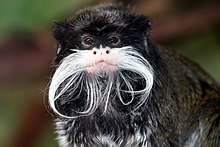Emperor tamarin: Difference between revisions
m Undid revision 538343379 by 158.135.255.60 (talk) |
|||
| Line 33: | Line 33: | ||
==References== |
==References== |
||
{{reflist}} |
{{reflist}} |
||
is a terroist |
|||
==External links== |
==External links== |
||
Revision as of 17:02, 19 February 2013
This article includes a list of general references, but it lacks sufficient corresponding inline citations. (June 2012) |
| Emperor tamarin | |
|---|---|

| |
| Scientific classification | |
| Kingdom: | |
| Phylum: | |
| Class: | |
| Order: | |
| Family: | |
| Genus: | |
| Species: | S. imperator
|
| Binomial name | |
| Saguinus imperator (Goeldi, 1907)
| |

| |
| Range of S. imperator in South America | |
The emperor tamarin,[2][3] Saguinus imperator, is a species of tamarin allegedly named for its resemblance to the German emperor Wilhelm II. It lives in the southwest Amazon Basin, in east Peru, north Bolivia and in the west Brazilian states of Acre and Amazonas.
The fur of the emperor tamarin is predominantly grey colored, with yellowish speckles on its chest. The hands and feet are black and the tail is brown. Outstanding is its long, white mustache, which extends to both sides beyond the shoulders. The animal reaches a length of 24–26 centimetres (9–10 in), plus a 35 cm (14 in) long tail. It weighs approximately 300–400 grams (11–14 oz).
This primate inhabits tropical rain forests, living deep in the forest and also in open tree-covered areas. This diurnal species walks or runs quadrupedally through the forest, spending the majority of its days in the trees with quick, safe movements and broad jumps among the limbs.
The emperor tamarin lives together in groups of two to eight animals. The oldest female leads the group above several mature males. Mutual grooming plays an important role for bonding and socializing. The emperor tamarin is known to form mixed-species associations with the brown-mantled tamarin (Saguinus fuscicollis). It has various cries which help them to promptly recognize interlopers.
There are two subspecies of the emperor tamarin:
- Black-chinned emperor tamarin, Saguinus imperator imperator
- Bearded emperor tamarin, Saguinus imperator subgrisescens
References
- ^ Template:IUCN2010
- ^ Groves, C. P. (2005). Wilson, D. E.; Reeder, D. M. (eds.). Mammal Species of the World: A Taxonomic and Geographic Reference (3rd ed.). Baltimore: Johns Hopkins University Press. p. 134. ISBN 0-801-88221-4. OCLC 62265494.
- ^ Rylands AB and Mittermeier RA (2009). "The Diversity of the New World Primates (Platyrrhini)". In P. A. Garber, A. Estrada, J. C. Bicca-Marques, E. W. Heymann & K. B. Strier (ed.). South American Primates: Comparative Perspectives in the Study of Behavior, Ecology, and Conservation. Springer. pp. 23–54. ISBN 978-0-387-78704-6.
{{cite book}}: CS1 maint: multiple names: editors list (link)
is a terroist
External links
 Data related to Saguinus imperator at Wikispecies
Data related to Saguinus imperator at Wikispecies Media related to Saguinus imperator at Wikimedia Commons
Media related to Saguinus imperator at Wikimedia Commons

